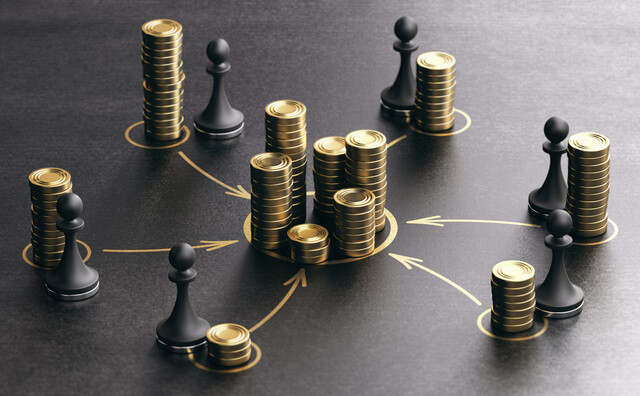So, what exactly is credit and how did it become something that we all use and need throughout our day-to-day lives?
Essentially, credit is the granting of a loan from one party to another, where the second party is not required to reimburse the first party in full immediately, but can repay over a certain set period of time. This is debt, and it affects nearly everyone in the Western world.
Typically, any large movement of financial capital is dependent on credit, and this becomes dependent on the reputation of the individual for how much credit they are allowed to borrow, often called creditworthiness.
Credit has become a huge part of our lives and it is actually very hard to get away from it. Many companies these days will offer credit to their customers as part of a purchase agreement. It is rare these days, when you make a payment at the till, that you are not asked if you want to get the company's credit card for cheaper purchases. Many choose to go with these store credit cards on impulse alone, which can have problems for many in the future.
| Forms of Credit |
There are several forms of credit that a person or company can have, with the most common being:
-
Credit Cards
-
Mortgages
-
Car Loans
-
Lines of Credit
-
Leases
-
Loans
These are just a few of the types of credit a company or person can have, but they are by far the most common of all the types.
| Credit Stats |
In the United States, credit is a way of life, but what are the stats that relate to it? How do you compare as a consumer to other consumers with your credit situation? Are you above, or below the average, and do you have something to worry about?
In terms of total consumer credit on credit cards, it equals an astonishing $1.7 trillion. Each American has an average of about $8,562 credit card debt at this very moment, and the total finance charges that are paid by Americans each year is about $50 billion.
Most households -- 78 percent -- are deemed credit worthy by the lending industry, but that being said, about 1.3 million people declare bankruptcy each year.
One very good indication of how much people are in debt is their debt-to-income ratio. This ratio, which will be addressed later in more detail, determines just how much someone pays from their net income toward debt payments. Right now, the average ratio is about 14 percent. That means that the average consumer uses 14 percent of their yearly income to pay their mortgage, as well as auto and personal loans, and credit cards. That means that if you make $33,000 per year, net-income, then you pay $4,620 each year in debt payments.
| Conclusion |
Credit is a unique beast. It is something that everyone uses, and everyone needs, but it can be a double-edged sword for many. While it can give you a house, car, and items you really cannot afford, it can also spiral out of control and begin to hold you down as you attempt to rise above the debt water before you are swept away.
|
The credit score is so important, that nearly everything you do with your credit will have an effect on it. It is there so that companies can quickly look at your score and know exactly how well you are suited for paying back the loan, based on the score. It could tell them that you borrow too much, that you do not pay back your debt, or that you are rebuilding your credit.
|
| FICO Score |
Standing for Fair Isaac Corporation, this company is the most widely-used credit score model in the United States. This score is calculated through statistics based on the information in the credit files of the consumer. This is used mostly by banks and other providers of unsecured and secured credit, and many people have had their loan denied because of their FICO score.
The FICO score ranges from 300, the worst, to 850, which is the best. This allows people to see their score as if it were a number, and that also allows them to quickly see where they sit in terms of their credit. This number is then used to determine if the person can get a mortgage, automobile loan, or consumer credit like a credit card.
This score can change greatly, and it is not unusual for the score to actually change by as much as 50 points depending on what may be on the person's credit that day.
| How Is The Score Calculated? |
The calculation of the score depends on a large number of factors from your credit history. When the score is made, it is compared with other borrowers. For example, someone who has two 30-day late payments will be compared with a borrower that has a similar history. The borrower will then be graded according to the risk variables that are used by the scoring model, ranking him within his or her group of borrowers. However, there are rules that the credit score must comply with and that includes not allowing race, skin color, religion, national origin, gender, and marital status to affect the credit score in any way. As well, if someone is denied for a loan application, the lender must state on the credit report of the borrower why they were denied. It cannot be as simple as "did not score high enough," and specific reasons must be given for the denial. These measures are in place to protect the consumer from borrowers conspiring against them.
-
35 percent is based on the punctuality of payments in the past
-
30 percent is based on the amount of debt compared to the borrower's income.
-
15 percent is based on the length of credit history
-
10 percent is based on the type of credit that is used.
-
10 percent is based on the credit they have obtained recently.
However, that is not all that the credit score is based on by any means. As well, if any money is owed because of a court judgment, lien, or anything else, it will affect the credit score.
| Range of Scores |
The different scores that you can have with FICO is quite diverse, and where you sit determines how much credit you can get. As we stated, the credit score for FICO ranges between 300 and 850, with about 60 percent of all people sitting between 650 and 799. The median score is 723 for FICO, with the average score being 678.
The breakdown for the score is as follows:
-
If you have a credit score of under 400, then you have horrible credit. You will not be able to get a loan and it is going to be very difficult for you to climb back up to good credit.
-
A credit score of 400 to 500 is very bad, and it is highly unlikely you will do any better for your loans until you can get your score much higher.
-
A credit score of 500 to 600 is very low, but you may still get a loan. However, if you do get a loan, it will be at a very high interest rate to handle the risk of your poor credit history.
-
A credit score of 600 to 700 is good credit and you should be able to get most loans, but your interest will be high if you are in the lower 600s, rather than the upper 600s.
-
A credit score of 700 to 800 is great credit and you will be able to get any loan that you want.
-
A credit score above 800 is perfect credit. If this is you, you have no problem getting loans, interest rates are low, and your need for collateral is also low.
























